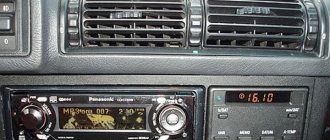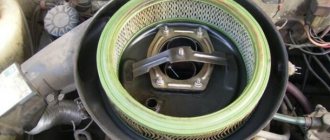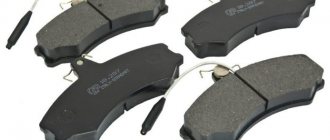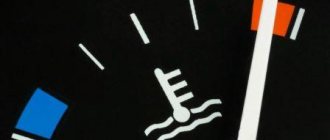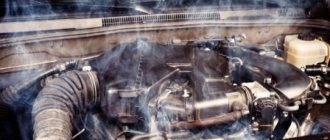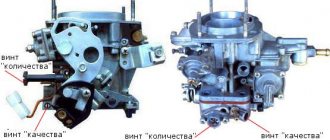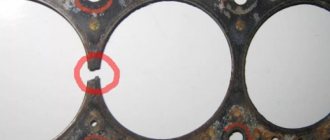Is the starter humming but not turning over the engine? Read what the problem is
After turning the key in the ignition switch, current is supplied to the starter winding. The drive gear (Bendix) interacts with the flywheel and after reaching operating speed, it is disconnected. The circuit opens, the key returns to the middle position and the starter shaft stops working.
The starter hums, but does not turn the engine
. This malfunction occurs for several reasons. Most often, problems are associated with the bendix, gear teeth, and wiring of the solenoid relay. Let's look at everything in order:
- Gear malfunctions
. Due to wear of the element in question, the teeth cannot physically engage with the flywheel, as they lose their original appearance and function. Excessive wear can be caused by improper use of the starter by the driver, use of the wrong oil in winter when it thickens, or prolonged activation of the starter when starting.
Gear misalignment
. The drive element of the starter drive engages with the flywheel only at its edge. The reason for this may be the failure of the bendix spring. A characteristic metallic grinding sound is heard, and when the starter is activated for a long time, the teeth of the flywheel or drive break;
Plug fault
. If the pushing fork is deformed, the relay will be activated, but the drive gear will not advance until the clutch engages and the engine will not start;
Electrical failure
. Worn brushes, oxidation of terminals or other faults in the wiring do not allow the flywheel to accelerate to the required speed. You can hear this by the clearly inadequate rotation speed of the starter.
The appearance of a squeal from the starter after turning the ignition key is an unpleasant problem, to say the least. However, like most other problems, it can be solved. And since the engine is still not a pig, you shouldn’t let it “squeal”, because the problem is quite serious, and if you postpone its solution “for later”, the cost of the solution will increase sharply.
Starter operating principle
The overrunning clutch or bendix is one of the most important components of the starter. When the engine starts running, the starter is in close proximity to the flywheel, and it is the overrunning clutch that is the mechanical means that, after starting the engine, removes the starter from the flywheel. If the overrunning clutch does not fulfill its task, the flywheel, spinning the starter, actually leads to its destruction. For the car owner, this problem is expressed by a squealing sound when the engine starts.
Possible causes of malfunction
- high degree of wear of the overrunning clutch;
- damage or severe contamination of the spline on which the overrunning clutch is attached;
- malfunction of the overrunning clutch drive (“fork”).
The most common problem that causes the starter to squeal can be considered the second problem, and it is in the form of contamination. But you can eliminate the problem literally in no time - just clean the starter.
Starter disassembly process
- Remove the retractor;
- Remove the front part of the starter;
- We clean the starter rotor shaft, the “worm”, and the overrunning clutch itself.
For the third point, gasoline or special solvents are used (in no case water!). In some cases, the ubiquitous WD-40 can be used, at least at the initial stage. Solvent or regular gasoline allows you to get rid of dirt accumulations, even if the situation is already close to critical. If, even after cleaning, the acoustic situation has not improved, it is better to replace the bendix (overrunning clutch).
I was getting ready to go on a long journey (3000 km) and a problem arose with the starter. There is a day to do something or do nothing. Car 21102 mileage 12000 km. 2 years After starting a cold engine, the starter whistles for 1-3 seconds. after which the whistle disappears. The whistle also appears when the ignition is turned on and off quickly (1-3 seconds), when the engine does not have time to start or does not even turn over (the retractor relay practically does not have time to operate). The whistling sound resembles the whistling of a generator belt. When hot everything is fine. Bendex doesn't seem to be sticking.
I was going to visit relatives for a week. Please tell me what could be wrong and how to fix it, or the starter will still work without consequences for the car. I know how the starter works and works.
| to come back to the beginning |
| Y103 |
| Maric wrote: |
| Hi all. |
I was getting ready to go on a long journey (3000 km) and a problem arose with the starter. There is a day to do something or do nothing. Car 21102 mileage 12000 km. 2 years After starting a cold engine, the starter whistles for 1-3 seconds. after which the whistle disappears. The whistle also appears when the ignition is turned on and off quickly (1-3 seconds), when the engine does not have time to start or does not even turn over (the retractor relay practically does not have time to operate). The whistling sound resembles the whistling of a generator belt. When hot everything is fine. Bendex doesn't seem to be sticking.
I was going to visit relatives for a week. Please tell me what could be wrong and how to fix it, or the starter will still work without consequences for the car. I know how the starter works and works.
Thank you in advance. I would say it differently. If something whistles from under the hood during a cold start, then the source could be the generator (belt or bearing). If something squeals, it is most likely the starter squealing. The starter is removed, the bendix (lithol) and the bendix shaft (machine oil) are lubricated, provided that all the bushings are intact. You can check the generator by removing the belt and starting it again.
Last day I inspected the starter. All bushings are ok. I smeared what I could. Although I didn’t find anything for lubrication other than the planetary gear, or I don’t know what exactly and where to lubricate it. The whistle remained. I think it's all about bendex. There’s nothing I can do if I launch it from the pusher. One thing worries me: could there be something wrong with the engine, i.e. Could the starter jam when starting and something could happen to the injector due to a power surge? By the way, I have a starter protection relay. And changing bendex (if that’s what it is) is not a problem if it comes to that.
The starter continues to operate after the engine starts
When the engine starts and you release the ignition key, the power supply to the traction relay stops and the bendix returns to its original position under the action of a spring.
If power continues to flow, this most likely indicates soldering of the main contacts in the solenoid.
The first thing to do is exclude the battery and generator from the list of possible causes.
Don't forget that the starter only works properly if the battery is fully (or sufficiently) charged.
Therefore, if the engine does not start, try starting it from an external power source using special connecting wires or use a jump starter.
After a successful start, it becomes clear that the problem lies in the electrical system.
Causes and ways to eliminate whistling from under the hood
Many faults in a car can be determined by sound. When some extraneous noise appears in the form of an incomprehensible knock, grinding, howling or whistling, this may indicate a breakdown of one of the car components. Some malfunctions are quite easily eliminated along with accompanying symptoms in the form of annoying and disgusting sounds. But there are certain signs of breakdowns that appear most often. Most often, a whistle is heard when starting the engine, which can be caused by a number of factors. Moreover, similar unpleasant sounds can occur even when the engine is already running. Next, we will talk about the causes of such phenomena and ways to eliminate them.
Causes
Why is there a crackling and grinding sound when starting the engine? This question is often asked by beginners and not-so-motorists. Many people are frightened by the strange sound heard when starting the engine. Although in many cases this is not a difficult problem. But it still needs to be eliminated, and for this it’s good to know where to look for the problem. There are several places that produce crackling and grinding noises during startup:
- Starter;
- Flywheel;
- Roller mounting bolt (timing).
Knowing the main places of breakdowns, you will quickly find out where the main problem is. For a more accurate diagnosis, open the hood and ask someone to start the engine. If there are problems with the starter and flywheel, a cracking noise will be heard from the rear of the engine when the bolt is unscrewed at the front.
Engine whistling when starting and running
It's always nice to know that your car is in full working order and will not cause inconvenience at the most inopportune moment. However, this does not always happen and many car owners are faced with a number of manifestations of failure of some car parts. This makes people doubt their “iron horse”, and such a car will clearly not add positive emotions. The most common signal of a breakdown is a whistle when starting the engine. Moreover, it is faced not only by owners of old cars, but also by practically new ones that have recently left the dealership.
The reason why a whistle is heard when the engine is running can be a number of different malfunctions in the car engine. Usually this is not so much a dangerous sign as it is annoying. Although, if the engine begins to make such extraneous sounds and the engine whistles more and more, then it is clearly impossible to delay the elimination of this problem. Some ignored faults can lead to expensive repairs and a host of problems.
Belts
One of the main reasons for whistling when starting the engine is the belts of various drives in the engine compartment of the car. Poor tension and wear lead to the appearance of that same annoying whistle, which can intensify with increasing engine speed. Or, on the contrary, it may disappear when you press the gas pedal. In any case, the sound made by the belts is very audible and impossible not to notice.
When a whistle occurs, the first thing you need to do is check the tension of the drive belts.
The first step is to check the tension of all drive belts in the engine. If any of them is weakened, then it may slip, which leads to a whistle when the engine is running. In this case, you need to tighten the belt to the permissible limits in order to leave it with normal free play. Another reason for belt slippage can be dirt and oil that gets on them. In this case, it must be thoroughly cleaned, and it is best to replace it with a new one.
Most often, troubles in terms of noise emitted are caused by the alternator belt. A whistle appears when the engine starts and disappears when the engine speed increases, since the belt enters the same amplitude as the rollers and pulleys. This can lead to insufficient battery charge and all the ensuing problems. It also happens that the engine whistles, and then suddenly stops making this sound. However, no changes are immediately observed. This could be caused by a broken alternator belt. After it breaks, charging the battery while the engine is running stops. This is usually signaled by a special light on the instrument panel, but not all drivers notice it and attach some importance to it. Such inattentive car owners risk being left somewhere in a deserted place with a dead battery.
Another most common cause of whistling from the engine compartment of a car is the timing belt. Here the consequences of ignoring the problem can be much more serious than in the previous case. The problem here is not so much in the belt as in the bearing, but you should definitely pay attention to this. A broken timing belt may result in a major engine overhaul due to bent valves, costing a lot of money. Therefore, you need to respond to any kind of whistles during engine operation in a timely manner and not take the situation to extremes. This does not affect all types of motors, but the real problem is widespread.
In most cases, engine whistling when cold is caused by the same belts. If it disappears when the engine warms up, then the reason is definitely in them. In the cold season, there is a chance that the grease in the generator belt bearing may become very thick and the belt will not be able to turn the generator pulley, simply slipping. The solution to this problem can be replacing this lubricant and tensioning the generator belt. But before that, you need to make sure that the generator pulley generally rotates on its own and is not jammed. Therefore, as you can see, whistling on a cold engine can be eliminated quite easily.
Lada Priora Hatchback Pritvira › Logbook › Starter noise when starting the internal combustion engine. Solution
Evening in the house, citizens of Draivovsk.
As Mr. Presenter would say in the program “What? Where? When?”: “And we have a question from LadaRacing from Penza, attention to the screen.”
And now about the serious stuff. A sound that ate the nerve cells of more than one thousand drivers, making them blush in front of boys and beautiful girls. That same squealing pig under the hood. And all this is he - Starter! The problem is known on most Lada Priora older than 4-5 years. This misfortune has not spared my Porch, although it seems to be used little and carefully. The treatment is quite simple, which is what this post will be about. First things first. Tool:
— Ratchet — Socket head 13 — Socket head 8 — Curved screwdriver — Pliers
Time — about 2 hours.
So. First of all, disconnect the “-” terminal from the battery. Next, remove the air filter housing along with the mass air flow sensor, having previously disconnected the connector from it. We see the following picture
To remove, first unscrew the wire end nut. Then unscrew the 3 nuts securing the starter itself. The photo shows 2. Third from the bottom. We remove the starter from the engine compartment.
Next, we unscrew the 2 clamping bolts of the starter housing and get to the gear mechanism, which is clearly not full of lubricant.
Next, I personally disassembled the starter down to the screw for prevention. In order not to bore you, I will leave a link to a detailed manual of which there are many on the Internet HOW TO DISASSEMBLE THE STARTER
I took it apart to this extent.
After complete disassembly, wash out the old grease using gasoline or solvent. Particular attention to the gear mechanism and bendix. Well, bushings wouldn't be bad.
We carry out the assembly in the reverse order; you should be especially careful with the brush assembly. Lubricate all rubbing parts with grease. Personally, I recommend Chevron.
But I didn’t have it on hand, so I used Litol 24. The difference is small, but it is there.
We install it on the engine and enjoy the completely different sound of the starter. I was surprised how quietly it can work. Unfortunately there is no video. But take my word for it.
I am ready to answer all questions and suggestions both in comments and in private messages. I wish you all a smooth road and silence under the hood. Best regards, LadaRacing
Source
What should you do if you hear a whistle coming from under the hood?
We have listed all possible malfunctions in which the motor and its components may whistle when starting the engine or during its operation. To eliminate most of them, the car owner does not need to have any special professional skills. You can handle replacing many belts and rollers, tensioning them, as well as cleaning the elements of the intake system yourself. But if you are not sure that you can cope with such problems, then it is better not to delay them, but contact a car service center to the experts in their field and then you can avoid much more expensive repairs and a lot of unnecessary troubles that can overtake you taken by surprise.
The starter clicks but does not turn, what is the reason?
Good afternoon. Many car enthusiasts are familiar with the situation when the starter clicks but does not turn. As luck would have it, such situations happen at the most inconvenient moments, for example, at gas stations or when leaving for work.
In today's article, we will tell you how to determine the malfunction and, if possible, start the car to get to the repair site.
Before telling the troubleshooting algorithm, let's look at the starter device. For clarity, watch this video:
As you can see, the starter is a regular DC motor and relay. When you turn the key in the ignition and hear a click, it is the solenoid relay that clicks (the coil and contacts at the top of the screen in the video). If the starter does not rotate, but clicks, the following options are possible:
- The battery is dead.
- starter relay failed
- The contact coins in the solenoid relay are burnt.
- The starter brushes are worn.
- the starter armature is jammed.
- power plus is not supplied to the starter (because if there is no mass there will not even be retractor clicks)
Below we will analyze each of these faults in detail, and tell you which faults will allow you to start the car on the spot, using the existing starter, in order to get to the service station.
A severely discharged battery is the most common cause of clicking noises when turning the ignition key.
The error looks like this:
In our video you can see that when starting, at first, the starter barely turns the engine, and then it just crackles…. If the battery is severely discharged, the starter will not even try to crank the engine but will immediately make nasty clicking noises.

